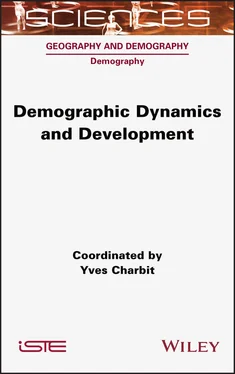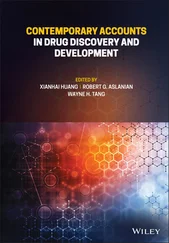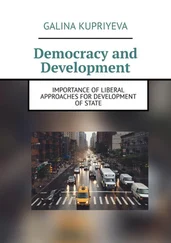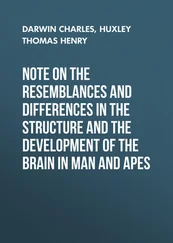1 Cover
2 Title Page SCIENCES Geography and Demography , Field Director – Denise Pumain Demography , Subject Head – Brigitte Baccaïni
3 Copyright First published 2022 in Great Britain and the United States by ISTE Ltd and John Wiley & Sons, Inc. Apart from any fair dealing for the purposes of research or private study, or criticism or review, as permitted under the Copyright, Designs and Patents Act 1988, this publication may only be reproduced, stored or transmitted, in any form or by any means, with the prior permission in writing of the publishers, or in the case of reprographic reproduction in accordance with the terms and licenses issued by the CLA. Enquiries concerning reproduction outside these terms should be sent to the publishers at the undermentioned address: ISTE Ltd 27-37 St George’s Road London SW19 4EU UK www.iste.co.uk John Wiley & Sons, Inc. 111 River Street Hoboken, NJ 07030 USA www.wiley.com © ISTE Ltd 2022 The rights of Yves Charbit to be identified as the author of this work have been asserted by him in accordance with the Copyright, Designs and Patents Act 1988. Library of Congress Control Number: 2021947914 British Library Cataloguing-in-Publication Data A CIP record for this book is available from the British Library ISBN 978-1-78945-050-7 ERC code: LS8 Ecology, Evolution and Environmental Biology LS8_3 Population biology, population dynamics, population genetics SH1 Individuals, Markets and Organisations SH1_3 Development economics, health economics, education economics SH3 The Social World, Diversity, Population SH3_8 Population dynamics; households, family and fertility
4 Introduction Demographic Dynamics
I.1. What are demographic dynamics? I.2. The world population, now a useless concept? I.3. The double Malthusian progression I.4. Outine of the book I.5. References
5 1 The Demographic Transition 1.1. Introduction 1.2. Genesis of the demographic transition 1.3. World population changes and trends (2019–2100) 1.4. The demographic transition in the world 1.5. The demographic transition in Latin America and the Caribbean 1.6. Conclusion 1.7. References
6 2 Demographic Dividend and Dependency Ratios 2.1. Introduction 2.2. The dependency ratios, main indicators of the potential of a first demographic dividend 2.3. Sub-Saharan Africa in search of a demographic dividend 2.4. Conclusion 2.5. References
7 3 From the Demographic Dividend to Generational Economics 3.1. Introduction: transition and demographic dividend, generational economics 3.2. Data and method for calculating the demographic dividend 3.3. Results and discussion 3.4. Conclusion 3.5. Appendix: country and survey year for consumption and income profiles 3.6. References
8 4 Fertility and Nuptiality 4.1. Introduction: the decline of fertility in the world 4.2. The sociodemography of fertility 4.3. The sociodemography of precocious nuptiality 4.4. Conclusion 4.5. References
9 5 Contraception and Reproductive Rights 5.1. Introduction: population and the Sustainable Development Goals 5.2. Socially embedded preferences for childbearing 5.3. Trends in contraceptive use and unmet need for family planning 5.4. Reproductive rights, fertility intentions and socially embedded preferences 5.5. The relationship between fertility, contraception and abortion 5.6. Conclusion: the role of national policies in Bangladesh and Pakistan 5.7. References
10 6 Mortality and Health, the Factors Involved in Population Dynamics 6.1. Introduction 6.2. Mortality around the world: deep inequalities 6.3. Children’s and female mortality 6.4. Conclusion 6.5. References
11 7 Dynamics of Migration History in Western Europe 7.1. Introduction 7.2. Migrations in preindustrial times (1650–1750) 7.3. Migration in the age of early industry (1750–1815) 7.4. Migration in an age of urbanization and industrialization (1815–1914) 7.5. European migration in the 20th century 7.6. References
12 8 Current International Migrations 8.1. Introduction 8.2. Migration flows and migration stocks 8.3. Emigration of HQ workforce from developing countries 8.4. Theoretical perspectives 8.5. Conclusion: HQ emigration, a growth engine for human capital? 8.6. References
13 9 Aging 9.1. Introduction 9.2. The aging of the world population: a demographic revolution 9.3. A strong heterogeneity in aging and its consequences 9.4. Responding to population aging: three case studies 9.5. Conclusion 9.6. References
14 Conclusion: Complex Relationships Between Demographic Dynamics and Development C.1. Main lessons drawn from the chapters C.2. Avoiding two pitfalls C.3. References
15 List of Authors
16 Index
17 End User License Agreement
1 Introduction Demographic Dynamics Figure I.1. Annual growth rate of major groups (2015–2020 average, in %) Figure I.2. Annual growth rate of countries in Southern Africa and Southern Asia...
2 Chapter 1 Figure 1.1. Female life expectancy at birth per 5-year periods, 1950–2020. LAC (... Figure 1.2. Total fertility rate in Latin America and the Caribbean (LAC): 1960–...
3 Chapter 2Figure 2.1. Policies impacting, respectively, the demographic dependency ratio (...
4 Chapter 3Figure 3.1. Africa’s economic lifecycle compared to that of Asian countries Figure 3.2. Lifecycle deficit (LCD) in Africa and in East Asia Figure 3.3. Evolution of the economic support ratio in African countries, 1950–2...Figure 3.4. Evolution of the support ratio growth per African sub-region, 1975–2...
5 Chapter 4Figure 4.1. Percentage of fertility decline by continent and income level (1950–...Figure 4.2. Percentage of fertility decline in some countries (1950–2020) Figure 4.3. Declines in infant mortality and fertility (1960–1980) Figure 4.4. Sanitary conditions in Africa Figure 4.5. Educational conditions in Africa Figure 4.6. The process of land saturation Figure 4.7. Modernization theory Figure 4.8. Child labor
6 Chapter 5Figure 5.1. Trends in total population by region, estimates and projections 1950...Figure 5.2. Trends in total fertility rate by region, estimates and projections ...Figure 5.3. Conformist preferences for childbearing (reproduced from Dasgupta an...Figure 5.4. Trends in the availability of survey data on contraceptive use by su...Figure 5.5. Prevalence of modern contraceptive use among women aged 15–49 by reg...Figure 5.6. Estimates of the proportion of women of reproductive age using contr...Figure 5.7. Total fertility rate compared to modern contraceptive prevalence amo...Figure 5.8. Family planning indicators among married or in-union women in Bangla...
7 Chapter 6Figure 6.1. The evolution of life expectancy at birth depending on development l...Figure 6.2. Evolution of life expectancy at birth by major world region Figure 6.3. Evolution of life expectancy at birth in Africa Figure 6.4. Life expectancy at birth in 2018, depending on economic development ...Figure 6.5. Life expectancy at birth in 2018 by continent Figure 6.6. Life expectancy at birth in Africa and in Asia Figure 6.7. Infant and child mortality rate in 1990 and 2015 (per 1,000 live bir...Figure 6.8. Maternal Mortality Report (deaths per 100,000 live births)
8 Chapter 8Figure 8.1. Distribution of migratory movements between “North” and “South” coun...Figure 8.2. The 15 most numerous migrant populations from a country of origin to...
9 Chapter 9Figure 9.1. Evolution of the proportion of people aged 65+ (world population 195...Figure 9.2. Evolution of the proportion of people aged 65+ and under 5 (world po...Figure 9.3. Evolution of life expectancy at birth (world population 1950–2100) Figure 9.4. Evolution of the dependency ratio (65 years+/20–64 years) (world pop...Figure 9.5. Period of time required for the 60+ population to increase from 10% ...Figure 9.6. Proportion of pension recipients among those having reached the lega...Figure 9.7. Activity rate of the population aged 65+ (various African countries ...
Читать дальше












